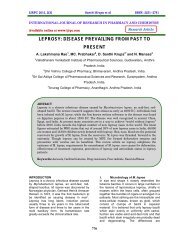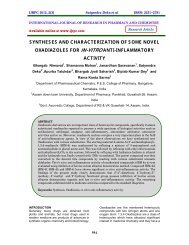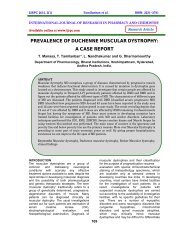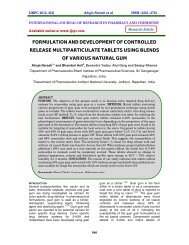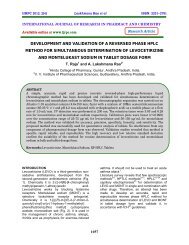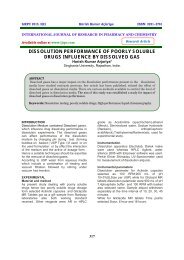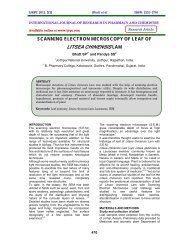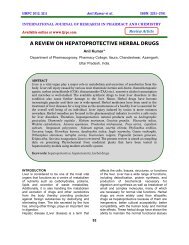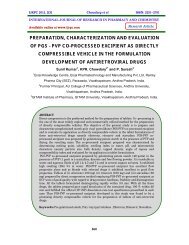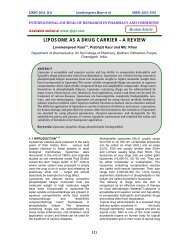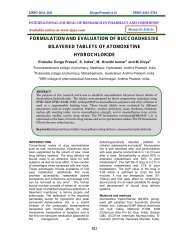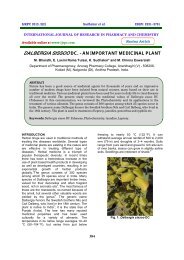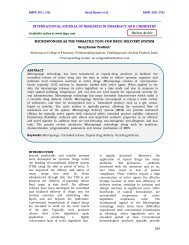antioxidant and anti inflammatory activities of thespesia ... - ijrpc
antioxidant and anti inflammatory activities of thespesia ... - ijrpc
antioxidant and anti inflammatory activities of thespesia ... - ijrpc
You also want an ePaper? Increase the reach of your titles
YUMPU automatically turns print PDFs into web optimized ePapers that Google loves.
IJRPC 2011, 1(3) Sai Koteswar sarma et al. ISSN: 22312781<br />
INTERNATIONAL JOURNAL OF RESEARCH IN PHARMACY AND CHEMISTRY<br />
Available online at www.<strong>ijrpc</strong>.com<br />
Research Article<br />
ANTIOXIDANT AND ANTI INFLAMMATORY ACTIVITIES OF<br />
THESPESIA POPULNEA LINN<br />
D. Sai koteswar sarma 1 *, A. Venkata Suresh Babu 2 <strong>and</strong> K. Rama Krishna 3<br />
1 Department <strong>of</strong> Pharmacognosy, Siddhartha institute <strong>of</strong> pharmaceutical sciences (SIPN),<br />
Narasaraopet, Guntur, Andhra Pradesh, India.<br />
2Department <strong>of</strong> Pharmaceutical Chemistry, Siddhartha institute <strong>of</strong> pharmaceutical sciences (SIPN),<br />
Narasaraopet, Guntur, Andhra Pradesh, India.<br />
3Department <strong>of</strong> Pharmaceutical Analysis, Siddhartha institute <strong>of</strong> pharmaceutical sciences (SIPN),<br />
Narasaraopet, Guntur, Andhra Pradesh, India.<br />
*Corresponding Author: dsksharma@gmail.com<br />
ABSTRACT<br />
The present study deals with the <strong><strong>anti</strong>oxidant</strong> <strong>and</strong> <strong>anti</strong> <strong>inflammatory</strong> <strong>activities</strong> <strong>of</strong> Thespesia<br />
Populnea. Antioxidant activity by nitric oxide method reveals that ethanolic extract <strong>of</strong><br />
Thespesia Populnea shows good results when compared to the st<strong>and</strong>ard drug (ascorbic acid).<br />
Antioxidants help to neutralize free radicals, which are unstable molecules that are linked to<br />
the development <strong>of</strong> a number <strong>of</strong> degenerative diseases such as cancer, cardiovascular<br />
diseases, cognitive impairment immune dysfunction, cataract <strong>and</strong> muscular degeneration.<br />
The in vitro <strong>anti</strong>-<strong>inflammatory</strong> activity was carried out by HRBC membrane stabilization<br />
method at a concentrations <strong>of</strong> 250, 500, 1000 µg/ml shows good <strong>anti</strong>-<strong>inflammatory</strong> activity<br />
when compared to the st<strong>and</strong>ard drug (dicl<strong>of</strong>enac sodium).<br />
Keywords: Thespesia Populnea, Malvaceae, HRBC membrane stabilization method<br />
INTRODUCTION<br />
Thespesia Populnea Linn commonly called as<br />
Hibiscus populnea belongs to the Family:<br />
Malvaceae. Thespesia populnea is an evergreen<br />
tree 1, 5, 6 . The Leaves are alternate, simple, with<br />
petioles <strong>of</strong> length 5-10cm long. The flowers <strong>of</strong><br />
Hibiscus like single at upper leaf axils, corolla<br />
yellow with a red center. The Fruits are<br />
Globose. The Seeds are Black, hairy. The main<br />
chemical constituents are Kaempferol,<br />
Quercetin <strong>and</strong> its glycosides, herbacetin <strong>and</strong><br />
its glucoside, populneol, populnin,<br />
populnetin, rutin, gossipetin, gossypol, lupeol,<br />
sesquiterpenoidal quinones such as thespeson,<br />
thespone, mansonones C, D, E <strong>and</strong> F, amino<br />
acids <strong>and</strong> carbohydrates. The main uses are<br />
Unripe fruit juice was used to cure piles.<br />
Decoction <strong>of</strong> bark was given to treat diarrhoea<br />
<strong>and</strong> arthritis. Root, fruit <strong>and</strong> leaf used in<br />
psoriasis, scabies <strong>and</strong> other cutaneous<br />
diseases. Bark was used for the treatment <strong>of</strong><br />
hemorrhoids <strong>and</strong> chronic dysentery. Leaf used<br />
as an <strong>anti</strong>-<strong>inflammatory</strong> 1-4 .<br />
MATERIALS AND METHODS<br />
The plant was collected from the surroundings<br />
<strong>of</strong> Kerala (Kollam district Punalur). It was<br />
authenticated by the botanist<br />
Pr<strong>of</strong>.P.Jayaraman M.Sc, Ph.D. (PARC),<br />
Tambaram, Chennai.<br />
ANTIOXIDANT ACTIVITY 3, 8<br />
Nitric oxide method<br />
The reaction mixture (3ml) containing sodium<br />
nitroprusside (10mM, 2ml), phosphate buffer<br />
674
IJRPC 2011, 1(3) Sai Koteswar sarma et al. ISSN: 22312781<br />
saline (0.5ml) <strong>and</strong> extract or st<strong>and</strong>ard solution<br />
(0.5ml) will be incubated at 25 o C for 150<br />
min.After incubation, 0.5 ml <strong>of</strong> the reaction<br />
mixture containing nitrate will be pipetted<br />
<strong>and</strong> mixed with 1 ml <strong>of</strong> sulphanilic acid<br />
reagent (0.33%i in 20% glacial acetic acid ) <strong>and</strong><br />
will be allowed to st<strong>and</strong> for 5 min for<br />
completing diazotization.Then 1 ml <strong>of</strong><br />
naphthylethylene diamine dihydrochloride<br />
(1%) will be added, mixed <strong>and</strong> will be allowed<br />
to st<strong>and</strong> for 30 min.The absorbance <strong>of</strong> these<br />
solutions will be measured at 540 nm. against<br />
the blank solution The percentage inhibition<br />
will be calculated by comparing the<br />
absorbance values <strong>of</strong> control <strong>and</strong> test by using<br />
the formula.<br />
(A control-A test)<br />
(%) scavenged= X 100<br />
A control<br />
A control is the absorbance <strong>of</strong> the control<br />
reaction mixture. A test is the absorbance <strong>of</strong><br />
sample <strong>of</strong> the extract at different<br />
concentrations<br />
ANTI INFLAMMATORY ACTIVITY<br />
HRBC MEMBRANE STABILIZATION<br />
METHOD 7<br />
Alsever solution prepared by 2% dextrose<br />
solution, 0.8% sodium citrate0.05% citric acid,<br />
<strong>and</strong> 0.42% sodium chloride dissolved in<br />
distilled water then the solution was sterilized.<br />
Blood was collected from cubital vein <strong>of</strong><br />
healthy volunteers. The collected blood was<br />
mixed with equal volume <strong>of</strong> sterilized alsever<br />
solution. The blood was centrifuged at 3000<br />
rpm <strong>and</strong> packed cells were washed with<br />
isosaline <strong>and</strong> a suspension <strong>of</strong>10 %( V/V)<br />
isosaline was made. Various concentrations <strong>of</strong><br />
ethanolic extract <strong>of</strong> Thespesia populenea were<br />
prepared in 1mlphosphate buffer, 2ml<br />
hyposaline <strong>and</strong> 0.5ml HRBC<br />
suspension.dicl<strong>of</strong>enac sodium was used as<br />
st<strong>and</strong>ard drug. The assay mixtures were<br />
incubated at 37°C for 30 minutes <strong>and</strong><br />
centrifuged. The hemoglobin content in the<br />
supernant solution was estimated using UV<br />
analysis at 560 nm.the percentage haemolysis<br />
was calculated by assuming heamolysis<br />
produced in the presence <strong>of</strong> distilled water as<br />
100%.the percentage <strong>of</strong> HRBC membrane<br />
stabilization produced was calculated by<br />
using the following equation.<br />
Percentage inhibition <strong>of</strong> haemolysis =<br />
100×OD1-OD2/OD1<br />
Where OD 1 <strong>and</strong> OD 2 are absorbance <strong>of</strong><br />
dicl<strong>of</strong>enac sodium <strong>and</strong> ethanolic extract <strong>of</strong><br />
Thespesia populnea<br />
RESULTS<br />
Antioxidant activity by nitric oxide method<br />
states that ethanolic extracts <strong>of</strong> Thespesia<br />
populnea shows better results when compared<br />
to the st<strong>and</strong>ard drug <strong>and</strong> it was mentioned in<br />
table no.1 & fig.no.1. Invitro <strong>anti</strong>-<strong>inflammatory</strong><br />
activity by HRBC membrane stabilization<br />
method shows that ethanolic extract <strong>of</strong><br />
Thespesia populnea gives better results when<br />
compared to the st<strong>and</strong>ard drug (dicl<strong>of</strong>enac<br />
sodium) <strong>and</strong> it was menttioned in table no.2 &<br />
fig.no.2.<br />
DISCUSSION<br />
The present study shows that the flavonoid<br />
rich fraction <strong>of</strong> Thespesia populnea possess a<br />
good in vitro <strong><strong>anti</strong>oxidant</strong> <strong>and</strong> in vitro <strong>anti</strong><strong>inflammatory</strong><br />
<strong>activities</strong>. Antioxidant activity<br />
by nitric oxide method states that ethanolic<br />
extracts <strong>of</strong> Thespesia populena shows good<br />
<strong><strong>anti</strong>oxidant</strong> activity when compared to<br />
st<strong>and</strong>ard drug (ascorbic acid). In both cases as<br />
concentration increases, % <strong>of</strong> scavenging<br />
activity also increases for both ethanolic<br />
extract <strong>and</strong> st<strong>and</strong>ard drug. Invitro <strong>anti</strong><strong>inflammatory</strong><br />
activity by HRBC membrane<br />
stabilization method at a concentration <strong>of</strong> 250,<br />
500, 1000 µg/ml shows that ethanolic extract<br />
<strong>of</strong> Thespesia populnea gives better results when<br />
compared to the st<strong>and</strong>ard drug (dicl<strong>of</strong>enac<br />
sodium).The presence <strong>of</strong> phenolic compounds<br />
such as tannins <strong>and</strong> flavonoids would have<br />
played a major role in exhibiting the biological<br />
activity.<br />
CONCLUSION<br />
The present study shows that the flavonoid<br />
rich fraction <strong>of</strong> Thespesia populnea possess a<br />
good in vitro <strong><strong>anti</strong>oxidant</strong> <strong>and</strong> in vitro <strong>anti</strong><strong>inflammatory</strong><br />
<strong>activities</strong>. It is due to the<br />
presence <strong>of</strong> phenolic compounds such as<br />
tannins <strong>and</strong> flavonoids would have played a<br />
major role in exhibiting the biological activity.<br />
675
IJRPC 2011, 1(3) Sai Koteswar sarma et al. ISSN: 22312781<br />
Table 1: Antioxidant values by nitric oxide<br />
method<br />
S. NO. Concentration<br />
%Inhibition<br />
For Test<br />
Drug<br />
%Inhibition<br />
For<br />
St<strong>and</strong>ard<br />
Drug<br />
1 31.25 21.94 64.94<br />
2 62.5 25.78 67.97<br />
3 125 37.21 71.99<br />
4 250 47.99 77.05<br />
5 500 53.63 84.22<br />
6 1000 65.69 88.58<br />
% Scavenging activity<br />
Nitric oxide<br />
scavenging activity<br />
100<br />
80 64.9467.971.99 77.05 84.22 88.58<br />
60<br />
40 21.9425.78 37.2147.99 53.63 65.69<br />
20<br />
0<br />
Concentration (µg/ml)<br />
St<strong>and</strong>ard<br />
Test<br />
Fig. 1: In-Vitro Anti-<strong>inflammatory</strong> by HRBC<br />
Membrane stabilization method<br />
%INHIBITION<br />
80<br />
60<br />
40<br />
20<br />
0<br />
1000<br />
500<br />
250<br />
Dicl<strong>of</strong>en…<br />
Test<br />
drug<br />
CONCENTRATION …<br />
Table 2: Effect <strong>of</strong> Ethanolic extract <strong>of</strong><br />
Thespesia populnea on human erythrocyte<br />
haemolysis<br />
S. No. Concentration<br />
(µg/ml)<br />
%Inhibition<br />
1 250 28<br />
2 500 46<br />
3 1000 63<br />
4 50 (STANDARD) 71<br />
REFERENCES<br />
1. Asima chatterjee <strong>and</strong> Satyesh Ch<strong>and</strong>ra<br />
Pakrashi. The treative on Indian<br />
Medicinal Plants. 2:188.<br />
2. Ghosh K <strong>and</strong> Bhattacharya TK.<br />
Preliminary study on the<br />
<strong>anti</strong>implantation activity <strong>of</strong><br />
compounds from the extracts <strong>of</strong> seeds<br />
<strong>of</strong> Thespesia populnea. Indian J<br />
Pharmacol. 2004;36:288-291.<br />
3. Johnson JI, G<strong>and</strong>hidasan R <strong>and</strong><br />
Murugesan R. Cytotoxicity <strong>and</strong><br />
superoxide anion generation by some<br />
naturally occurring quinines. Free<br />
Radical Biology <strong>and</strong> Medicine.<br />
1999;26:1072-1078.<br />
4. Mani Vasudevan, Kumar Kishore<br />
Gunnam <strong>and</strong> Milind Parle.<br />
Antinociceptive <strong>and</strong> <strong>anti</strong><strong>inflammatory</strong><br />
effects <strong>of</strong> Thespesia<br />
populnea bark extract. J<br />
Ethanopharmacology. 2007;109:264-<br />
270.<br />
5. Nadkarni KM. Indian Materia Medica.<br />
Edn-3: 629.<br />
6. Patil DA. Herbal Cures, Traditional<br />
Approach, Aavishkar publishers,<br />
Jaipur. 2008, Edn 1: 214.<br />
7. Shinde UA, Phadke AS, Nair AM,<br />
Mung<strong>anti</strong>war AS, Dikshit VJ <strong>and</strong> Saraf<br />
VO. Membrane stabilizing activity a<br />
possible mechanism<strong>of</strong> action for the<br />
<strong>anti</strong>-<strong>inflammatory</strong> activity <strong>of</strong> Cedrus<br />
deodara wood oil. Fitotherapia.<br />
1999;70:251-57.<br />
8. Tenpe CR, Upaganlawar Aman,<br />
Bhagat Amol <strong>and</strong> yeole PG. InVitro<br />
<strong><strong>anti</strong>oxidant</strong> <strong>and</strong> free radical<br />
scavenging activity <strong>of</strong> Jasminum<br />
sambac Linn.leaves. Phcog Mag.<br />
2008;4(15):124-128.<br />
Fig. 2<br />
676



